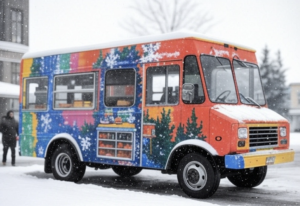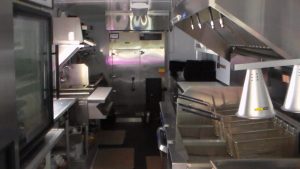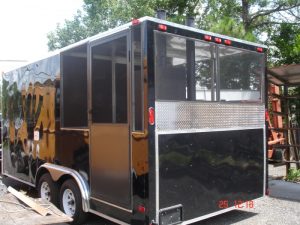After 20+ years in the food truck business, both building and maintaining these mobile kitchens, I’ve seen firsthand what winter can do to a food truck that isn’t properly prepared. Here in the northern states, winter isn’t just a slow season – it’s a serious challenge for your equipment. I’m going to share my personal insights on how to protect your investment during those cold months.
The Reality of Winter Storage
Let me be straight with you: storing a food truck for winter isn’t as simple as parking it and walking away. I’ve had customers come to me in spring with horror stories about frozen pipes, dead batteries, and even worse – mold growth that required complete kitchen overhauls. These are expensive lessons that I don’t want you to learn the hard way.
Starting With the Basics: Mechanical Prep
First things first – let’s talk about what I call the “golden rule” of winter storage. Your truck needs to go into hibernation in top condition. Here’s my checklist that I share with every customer:
1. Fill up with fresh fuel and add a high-quality fuel stabilizer. I personally recommend Star Tron Enzyme Fuel Treatment – I’ve seen it keep fuel fresh for up to two years. Drive the truck for at least 15 miles after adding it to ensure it runs through the entire system.
2. Change your oil and all filters (fuel, air, and oil). Cold starts are tough on engines, and fresh oil gives you the best protection. I suggest using a synthetic oil with a lower viscosity rating for winter – something like 5W-30 that flows better in cold conditions.
3. Check and replace all belts and hoses. The cold makes rubber brittle, and I can’t tell you how many times I’ve seen a belt snap during the first spring startup because it was already worn going into winter.

Food truck in the snow.
The Kitchen Equipment Challenge
This is where food trucks differ from regular vehicles, and it’s crucial to get it right. Here’s what I do with my own trucks:
1. Deep clean all equipment with a degreaser. Any residual grease can become rancid and attract pests. I suggest using a commercial-grade degreaser like Super Clean, diluted properly.
2. Remove all portable equipment if you’re storing in an unheated space. This includes:
– Mixers and food processors
– POS systems and tablets
– Fire extinguishers (store these in a temperature-controlled environment)
– Removable gaskets from refrigeration units
3. For fixed equipment:
– Drain all water lines completely
– Add food-grade antifreeze to P-traps
– Leave refrigerator and freezer doors slightly open with moisture absorbers inside
– Cover all stainless steel surfaces with food-grade mineral oil to prevent corrosion
Plumbing System Protection
Let me be absolutely clear about this: your plumbing system is the most vulnerable part of your food truck during winter storage. I’ve seen burst pipes cause catastrophic damage that costs upwards of $5,000 to repair, not to mention delaying season openings by weeks. Even a small amount of water left in your lines can expand when frozen and crack your pipes, fittings, or water heater. That’s why I’ve developed this foolproof method over years of winterizing hundreds of trucks.
Start with your water tanks – both fresh and grey water need to be completely emptied. I mean completely. I recommend opening the drain valves and then driving the truck around the block to ensure any pockets of water get sloshed out. For the grey water tank, give it a thorough flush with clean water first – any grease or food particles left behind can cause nasty odors and bacteria growth during storage.
Once the tanks are empty, move on to the lines. Open every single faucet and valve in your truck – hot and cold sides. Don’t forget those easily overlooked valves like the ones under your sinks or the external spray nozzles. Now, here’s where a lot of people go wrong – they think gravity will do the job. It won’t. You need compressed air, but be careful with the pressure. I use exactly 30 PSI – any higher can damage your lines, any lower might not clear them completely. Connect the air compressor to your city water inlet and listen for air spurting from all your open faucets. Keep the air flowing until you’re certain no more water is coming out.

Go through a winter checklist before putting your unit in storage for the winter.
Next comes the antifreeze step – but not just any antifreeze. You need specific RV/marine antifreeze rated for potable water systems. The pink stuff, rated to -50°F. Pour about a cup down each drain, including your hand-washing sink and any floor drains. This creates a protective barrier in your P-traps and prevents any residual water from freezing and cracking the fittings.
Don’t forget about your water filters – they’re expensive to replace and can be easily damaged by freezing. Remove them, let them dry completely, and store them in a sealed plastic bag in a temperature-controlled environment. Label each filter with its location in the truck – you’d be surprised how easy it is to forget which one goes where after a few months.
Finally, tackle the water heater. This is crucial because a cracked water heater can cost over $1,000 to replace. Turn off the power, disconnect it, and use the pressure relief valve to ensure it drains completely. Some models have a separate drain plug – remove it if yours does. I actually use my air compressor here too, giving it a quick blast to ensure no water is trapped inside.
Electrical Systems and Battery Care
When it comes to electrical systems in food trucks, winter storage presents some unique challenges that go beyond what you’d face with a regular vehicle. Most food trucks run multiple battery systems – you’ve got your vehicle battery, possibly deep cycle batteries for kitchen equipment, and maybe even batteries for POS systems or lighting. Each one of these represents a significant investment, and I’ve seen far too many operators lose hundreds of dollars by neglecting proper battery care during the off-season. Cold temperatures are particularly hard on batteries, potentially reducing their capacity permanently if they’re not properly maintained.

Prep your food truck inside and out for winterization.
What makes food truck batteries especially vulnerable is the extensive electrical system they’re connected to. Unlike regular vehicles, food trucks often have complex wiring setups for kitchen equipment, ventilation systems, and point-of-sale devices. During winter storage, any small power drain from these systems can slowly deplete your batteries, and if they discharge completely in freezing temperatures, you’re likely looking at replacement rather than rehabilitation. I learned this lesson early in my career when a customer lost three expensive deep cycle batteries after a particularly cold winter – an expensive mistake that could have been prevented with proper storage procedures.
I’ve developed a specific approach to battery maintenance over the years:
1. Remove the battery and store it in a temperature-controlled environment
2. Use a smart battery maintainer – I recommend the NOCO Genius10 because it has specific settings for deep cycle batteries
3. Check battery water levels monthly if you have a lead-acid battery
4. Clean terminal connections and apply dielectric grease before removal
External Protection
The exterior needs just as much attention as the interior:
1. Wash and wax the exterior thoroughly. I use a ceramic coating on my trucks – it’s an investment but provides excellent protection
2. Apply a heavy-duty rubber conditioner to all seals and gaskets
3. Spray all locks and hinges with a dry lubricant (wet lubricants can freeze)
4. Place steel wool in the exhaust pipe (with a small tag hanging out as a reminder to remove it)
5. Cover with a breathable cover – I use a custom-fitted cover with vents that prevents moisture buildup
Protecting Your Tires and Suspension
One of the most common issues I see with stored food trucks is tire damage, and it’s completely preventable with the right approach. While modern tires are more resistant to flat-spotting than older ones, sitting in one position for months can still cause problems. I’ve found that over-inflating the tires by about 5-8 PSI before storage helps prevent this issue. However, if you’re planning to store your truck for more than three months, I strongly recommend getting it up off the ground entirely.
In my facility, we use heavy-duty jack stands rated for commercial vehicles, placing them at the truck’s designated lift points. This not only protects the tires but also helps prevent suspension components from settling unevenly. If you’re storing your truck in a high-traffic area or shared storage facility, you might want to consider removing the tires completely. I’ve seen too many cases of accidental damage from other vehicles or equipment moving around in tight storage spaces. Just make sure you store the removed tires properly – lying flat in a cool, dry place, away from direct sunlight and any ozone-producing equipment.

Inspect tires before winter storage.
Here’s a crucial tip that’s often overlooked: never, ever leave your parking brake engaged during long-term storage. I learned this lesson the hard way years ago when a customer’s brake cables seized up after being left engaged for four months in winter storage. Instead, use proper wheel chocks – I recommend heavy-duty rubber ones rather than wooden blocks, as they’re more stable and won’t rot or deteriorate. Place them snugly against both sides of the wheels, and if you’re storing on any kind of incline, use additional chocks for safety.
Regular Maintenance During Storage
One of the biggest mistakes I see food truck owners make is treating winter storage like a “set it and forget it” situation. I get it – when you’re not generating revenue, it’s tempting to just lock up the truck and walk away until spring. But I’ve learned through costly experience that regular checks during storage are absolutely essential. The worst problems I’ve encountered in my years of servicing food trucks weren’t from major system failures – they were from small issues that went unnoticed for months and snowballed into expensive disasters. A small water leak that could have been fixed with a $5 seal ended up causing $3,000 in mold remediation because nobody checked on the truck for three months.
I remember one particularly painful lesson from early in my career when a client’s generator seized up after sitting unused all winter. The fuel had gelled, seals had dried out, and what should have been routine maintenance turned into a complete generator replacement. That’s why I now insist on regular maintenance checks, even during storage. These visits don’t need to be lengthy – usually 30 minutes once a month is enough to catch potential issues before they become major problems. Think of it as an insurance policy for your investment. I actually schedule these checks on my calendar like any other business appointment, because that’s exactly what they are – critical business maintenance.
Even in storage, your truck needs attention. Here’s a monthly checklist I suggest implementing with your vehicle:
1. Run the generator for 15 minutes (if equipped)
2. Check for pest evidence
3. Look for water intrusion
4. Verify battery maintainer operation
5. Check tire pressure
6. Run ventilation fans briefly
7. Inspect for any signs of mold or mildew
Insurance and Documentation
Here’s a tip that can save you money: Contact your insurance provider about storage insurance. Many offer significant discounts for stored vehicles. Just make sure to maintain comprehensive coverage – I’ve seen too many cases of theft or damage during storage.

Do you sell during the winter?
Spring Startup Preparation
Before you end storage, create a startup checklist. Mine includes:
1. Reverse all winterizing steps systematically
2. Check all systems before adding water or power
3. Start with a professional inspection
4. Test all equipment at low volume before going full operation
Final Thoughts
Remember, proper winterization is an investment in your business’s future. I’ve seen trucks that were properly winterized still running perfectly after 10+ years, while others needed major repairs after just one poorly managed winter.
The key is being thorough and systematic. Don’t cut corners – the money you save now could cost you thousands in repairs later. If you’re unsure about any part of this process, please consult with a professional. It’s better to spend a little more on proper winterization than to face major repairs in spring.
Feel free to reach out if you have specific questions about your truck’s winterization needs. Every truck is different, and I’m always happy to share what I’ve learned over the years in this business. Stay warm, and here’s to a successful spring reopening!

Leave A Comment